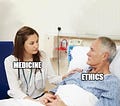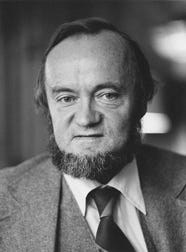Did Medicine Save the Life of Ethics?
In which we ask "What made medicine go asking advice from moral philosophers?!?" and contemplate, "Can anyone really rock a chin curtain?"
Ethics: “Thank you for saving me from languishing in obscurity”
Medicine: “NP, Imma need you to be about 90% more practical. Kthxbye”
The third reading in chapter 1 of Practical Bioethics is kind of an odd one out. Before it we have a big ole abstract reading from ethical pluralist Sir David Ross with the mind-bending title “What makes Right Actions Right?” (1930) and then we go back in time (1861) for a rebuttal from ethical monist John Stewart Mill. If you are a bioethics teacher, you might be wondering “Why did he put this Toulmin article in there?”
First I thought it prudent to include a reading from someone who was alive this century. Second, after Ross and Mill, my students find Toulmin positively transparent in his prose even if most of them were non-existent when he wrote it. But honestly I included it because of it’s provocative claim.
[P]roper attention to the example of medicine has helped to pave the way for a reintroduction of “objective” standards of good and harm and for a return to methods of practical reasoning about moral issues that are not available to either the dogmatists or the relativists.
NOTE: If you are an ethical monist then Toulmin isn’t your dude. If you are an ethical relativist, he’s REALLY not your dude.
What he’s claiming is that somewhere around the mid 1970s the medical community reached out to moral philosophy for some help with Medical Culture’s majorly embarrassing ethical violations.
What violations you say? You’ve probably heard about what medical culture did to Henrietta Lacks’ cells in the 1950s and students usually recall the Tuskegee Syphilis study (the longest non-therapeutic research study in history—more on this in chapter 4) which finally ended in 1972 after another scathing expose in the AP). You might not know that just ten years before, Life Magazine exposed the “God Panel” where “a lawyer, a minister, a banker, a housewife, an official of state government, a labor leader, and a surgeon” decided who got dialysis and who got dead.
You also might not know that in 1973, Donald “Dax” Cowart was given excruciating treatment for a year and a half against his expressed wishes for burns he suffered in an explosion. Unfortunately, I could go on and on and on.
[Tell you what I like about teaching bioethics, it’s the only philosophical discipline you can pinpoint its birth here in the US and there are new developments every year. Unlike Logical Positivism in which we can pinpoint both birth and death of the philosophical movement. (RIP Verifiability Principle. We hardly knew ye]
After those very public scandals, some people in the medical culture recognized they had a ethics problem. They went looking for some moral philosophers in land of Academia near Mt. Ivory Tower where moralists were in danger of languishing on a diet of abstract meta-reasoning and asphyxsiating on the rarefied air of their own echo-chambers. I’m only half kidding.
Toulmin’s thesis is that this intersection between medical culture and academic moral philosophy forced moral philosophy as a discipline to get serious about practical moral reasoning. Relativism wasn’t going to help medicine’s moral problem and neither was the stuffed corpse of dogmatic utilitarianism pace Jeremey Bentham.
Toulmin recounts that when he joined the national ethics committee that produced research ethics protocols like the Belmont report (Again see Ch. 4) he noticed something surprising. Despite being from different backgrounds and situations, the committee was able to actually come to consensus on what was morally acceptable faced with specific hard cases.
Faced with “hard cases,” they inquired what particular conflicts of claim or interest were exemplified in them, and they usually ended by balancing off those claims in very similar ways. Only when the individual members of the commission went on to explain their own particular “reasons” for supporting the general consensus did they begin to go seriously different ways.
In other words the committee started with specific cases and then justified their intuitions with divergent general principles.
Toulmin rocking the Lincoln chin curtain back in the day
Now, my late economist friend, Steve Horwitz, would say something like “anecdote is not a synonym for evidence” and even if I confirm that in the 13 plus years I’ve worked with medical ethics committees my experience was largely the same, Horwitz (quoting economist Paul Samuelson) would remind me, “The plural of anecdote is not data.”
With that caveat, let me say, what I learn from Toulmin (besides that not many people can pull off the chin curtain) is that the proper place to start in teaching and learning moral reasoning is with cases first, principles second, and maybe theory last.
This is what the collaboration with medical culture forced ethics to do. That’s why the article is in Ch. 1.
The approach in Practical Bioethics (PB) is also inspired by McDonough School of Business at Georgetown’s Business Ethics in a Box which is about the most practical and hands-on business ethics curriculum out there IMHO.
Start students with cases where they deliberate within a group (like the ethics committee cases in PB) and let them discover the principles as they go.






